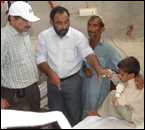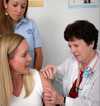December 17, 2010
Report of Human Infection with Swine Origin Influenza A (H3N2)
The December 17, 2010 FluView reported one human infection with swine origin influenza A (H3N2) virus in the state of Minnesota as part of U.S. surveillance and reporting of novel influenza A viruses. Test samples from one patient in Minnesota were confirmed at CDC as positive for swine origin triple-reassortant (tr) H3N2 influenza viruses—viruses that normally infect pigs. Although human infection with swine influenza viruses is rare, it can occur. This is most likely to occur when people are in close proximity to infected pigs, such as in pig barns and at livestock exhibits housing pigs at fairs. The patient in Minnesota with confirmed trH3N2 infection had exposure to pigs prior to illness onset. There is no documented human-to-human transmission of this virus or any evidence of community transmission at this time. An investigation of this case is ongoing. Cases of human infection with swine influenza viruses underscore the importance of ongoing human and animal influenza surveillance.
This case of human infection with swine origin influenza virus (SOIV) brings the total number of human infections with swine origin influenza viruses reported to CDC since 2005 to 19. Previously, five of these reports had been swine origin A (H3N2) viruses. The most recent Minnesota case brings the number of reports swine origin A (H3N2) infections in humans in the United States to six. Human infections with swine origin H3N2 virus infections have also been reported from Pennsylvania and Wisconsin in October and November 2010, Minnesota in May 2010, Iowa in September 2009, and Kansas in August 2009.
Swine influenza (swine flu) is a respiratory disease of pigs caused by type A influenza viruses that regularly cause outbreaks of influenza in pigs. Swine flu viruses can result in high illness rates in pig herds, but generally cause few deaths in pigs. Swine influenza viruses can circulate among pigs throughout the year, but most outbreaks occur during the late fall and winter months, similar to outbreaks in humans. There are four main influenza type A virus subtypes that have been isolated in pigs: H1N1, H1N2, H3N2 and H3N1. Most flu viruses circulating in pigs are referred to as "triple-reassortant" viruses because these flu viruses contain genes from human, swine and avian influenza viruses.
It's important to note that swine influenza viruses are not transmitted to humans by food. You cannot get swine influenza from eating pork or pork products. Eating properly handled and cooked pork and pork products is safe.
In 2007 human infections with novel influenza viruses such as swine influenza became nationally notifiable. Previously, CDC has received reports of approximately one human infection with a swine influenza virus every one to two years, but in the past few years, about four cases have been reported per year.
These trH3N2 viruses are different from the 2009 H1N1 virus that has been circulating in the United States since late April 2009. They are also different from human seasonal influenza A (H3N2) viruses that typically circulate among people during the flu season. Swine trH3N2 viruses commonly circulate in pigs in North America, but human infections are rarely detected. These viruses are different from the swine classical H1N1 or swine trH1N1 influenza viruses that also circulate in pigs in North America because they have H3N2 surface antigens. TrH3N2 viruses first were detected in North American swine herds in the late 1990s. The H3 and N2 genes originated from human seasonal H3N2 influenza viruses that circulated globally among humans in the late 1990s. However, currently circulating swine H3 and N2 genes are now notably different from human influenza virus H3 and N2 genes.
Although the vast majority of instances of human infection with animal influenza viruses do not result in human-to-human transmission, each case should be fully investigated to be sure that such viruses are not spreading among humans and to limit further exposure of humans to infected animals if infected animals are identified. Surveillance for both seasonal and novel influenza viruses is conducted by CDC and its state and local health partners year round.
For more information about swine influenza, visit http://www.cdc.gov/flu/swineflu/
Weekly U.S. surveillance updates are published in FluView and posted at http://www.cdc.gov/flu/weekly/fluactivitysurv.htm
December 8, 2010
Maximizing the Promise of Breakthrough Tuberculosis Test
The Federal TB Task Force* is collaborating to help ensure patients in the United States and around the world have access to a test that can revolutionize tuberculosis (TB) diagnosis and treatment. Xpert MTB/RIF is an automated test that can provide earlier and improved tuberculosis (TB) case detection. In studies, it has been shown to be an accurate and reliable test for diagnosing TB that does not require extensive laboratory safety measures.
This new test can detect TB and rifampicin resistance, a proxy for multidrug-resistant (MDR) TB, in less than 2 hours from a sample of respiratory fluid coughed up by a patient. Current laboratory tests for TB are skill intensive and require a minimum of 17 days for liquid culture and over 30 days for solid culture; drug-susceptibility testing requires an average of 75 days to get results. During this lag time, patients continue to suffer and can spread TB infection to others. Having TB test results within hours is an important step in improving patient-centered care and early case detection.
Xpert MTB/RIF is especially important for HIV-infected persons who are at greatest risk for rapid progression of TB disease, and in whom this disease is a leading cause of death. It is also important for persons at increased risk for MDR TB to prevent prolonged delays in diagnosis and to ensure appropriate treatment.
In 2009, the Federal TB Task Force released the Plan to Combat Extensively Drug-Resistant Tuberculosis (http://www.cdc.gov/mmwr/preview/mmwrhtml/rr5803a1.htm),calling for enhanced laboratory capacity and evaluation of rapid tests for the diagnosis of TB and the detection of drug resistance, both in the United States and worldwide. The Federal TB Task Force has also issued an international strategy for U.S. support for the Global Plan to Stop TB through the President's Emergency Plan for AIDS Relief (PEPFAR) and the Global Health Initiative.
Action Steps Being Taken
The Federal TB Task Force is aware of the global significance of a rapid and accurate tuberculosis test, and have been eager to accept and review data that would support the safety and effectiveness of such a test. However, the use of Xpert MTB/RIF has only been studied in countries with high rates of TB; thus, additional testing is needed in U.S. populations that have a low TB rate in order to secure Food and Drug Administration (FDA) approval and develop appropriate guidance for its use in our country. Recognizing the commitment other government agencies and support groups have made in the global fight against tuberculosis as well as the need to support medical device innovation, FDA, the National Institutes of Health (NIH), and the Centers for Disease Control and Prevention (CDC) recently held a public workshop on tuberculosis. Additionally, the FDA has been working with Cepheid, the manufacturer of Xpert MTB/RIF, on the pathway forward for seeking approval of their assay in the United States. Uptake of the Xpert MTB/RIF rapid diagnostic test will help both U.S. and global partners meet goals in reducing TB death and disease.
* The Federal Tuberculosis (TB) Task Force is a coalition composed of the federal agencies involved in U.S. TB research and control efforts. Established in 1991, it facilitates coordination of activities among these federal agencies. It was established under the leadership of the Director of the Centers for Disease Control and Prevention (CDC) (then William C. Roper, MD) to address the outbreaks of multidrug-resistant (MDR) TB occurring during the 1985-1992 surge in TB cases.
For additional information
- National Institute of Allergy and Infectious Diseases (NIAID): http://www.niaid.nih.gov/news/newsreleases/2010/Pages/TBdiagnostic.aspx
- World Health Organization: http://www.who.int/tb/features_archive/new_rapid_test/en/index.html
November 19, 2010
Avian Influenza A (H5N1) Human Infection in Hong Kong
On November 17, 2010, the Centre for Health Protection (CHP) of the Department of Health (DH), Hong Kong, China, reported a new confirmed case of human infection with avian influenza A (H5N1) virus to the World Health Organization (WHO). More information on the case is available in Communicable Diseases Watch, a publication of CHP DH, Hong Kong, China at http://www.chp.gov.hk/files/pdf/cdw_v7_24.pdf and on the WHO website at http://www.who.int/csr/don/2010_11_19/en/index.html.
This case occurs against a backdrop of endemic infection with highly pathogenic avian influenza A H5N1 viruses (HPAI) among poultry in Asia and other parts of the world and sporadic but fairly regular human infections with HPAI H5N1 viruses dating back to 2003. These viruses are "highly pathogenic" in birds. Most cases of human infection with HPAI H5N1 viruses have occurred following close contact with infected birds or being in a live poultry market. However, some limited human-to-human transmission of HPAI H5N1 has been documented.
The epizootic outbreak in Asia and other regions poses an important public health threat because if these HPAI H5N1 viruses gain the ability for efficient and sustained transmission between humans, an influenza pandemic could result because there is little preexisting natural immunity in the human population.
WHO tracks reports of human infections with H5N1viruses. To date, 508 such cases have been reported to WHO, with 302 of the patients dying. So far, a total of 21 human cases of HPAI H5N1 infection have been reported in Hong Kong SAR China, including 18 cases in 1997, two cases in 2003 and the current case in 2010.
The investigation into the case in Hong Kong is ongoing, however, according to the WHO report, "Evidence so far indicates a sporadic case of human influenza A (H5N1) infection without secondary spread."
There have been no reports of human infection with influenza A (H5N1) viruses in the United States, nor have there been any reports of highly pathogenic influenza A (H5N1) in U.S. birds or poultry.
CDC is monitoring the situation and remains in close contact with WHO and other international partners. More information about avian influenza is available at http://www.cdc.gov/flu/avian/gen-info/facts.htm.
Action Steps Being Taken
The U.S. Government CDC has issued a recommendation for enhanced domestic surveillance of avian influenza A (H5N1). This has been in effect since February 2004 and remains in effect to this day.
CDC has participated in trainings both internationally and at home to strengthen surveillance and laboratory testing techniques.
Pandemic preparedness plans and activities were tested in reality during the 2009 H1N1 pandemic.
HHS and CDC along with other partners such as WHO have implemented important initiatives that have improved influenza surveillance in Asia and other regions of the world.
There is a stockpile of 20 million doses of a vaccine against some strains of HPAI H5N1 viruses. Ongoing efforts to produce a broadly protective vaccine that would be effective against multiple influenza A H5N1 virus strains are under way.
There is a stockpile of antiviral medications to treat human infection with novel influenza viruses, including avian influenza A H5N1 in the Strategic National Stockpile.
November 15, 2010

Protecting Internationally Adopted Children from Lead Poisoning
Prospective parents adopting a child from overseas need information to safeguard the health of the child from lead poisoning, which can cause several health problems, including brain damage. The risk for lead exposure is much higher in many countries from which children are adopted than in the United States. Each country sets its own policies or regulations for environmental exposures, including lead, and some countries have stronger regulations than others. CDC has information on this topic for adoptive parents and health care providers.
November is National Adoption Month. The U.S. Department of State's Office of Children's Issues shows that from October 1, 2008, to September 30, 2009, a total of 12,753 internationally adopted children immigrated to the United States. The largest numbers of these children were originally from Ethiopia, mainland China, South Korea, and Russia.
Foreign-born adopted children tend to have higher levels of lead in their blood than children born in the United States. Readers can learn more about how internationally adopted children may have been exposed to lead before they came to the United States, and what they can do take to get the child proper diagnostic screenings and follow-up care if needed.
Important points to emphasize
Internationally adopted children can be exposed to lead from a number of sources including, cooking utensils and cosmetics, leaded gasoline, exhaust, drinking water from metal pipes or storage containers, exhaust and air pollution from nearby mining and smelting plants and industrial emissions.
Most children with elevated blood-lead levels do not have any symptom. Simple blood tests are the only way to determine if a child has an elevated blood lead level.
For more information about internation adoption, visit http://www.cdc.gov/nceh/lead/tips/adoption.htm and http://www.cdc.gov/immigrantrefugeehealth/adoption/.
Other resources include http://www.cdc.gov/nceh/lead/tips.htm and http://www.cdc.gov/Features/AdoptionHealth/.
November 12, 2010
Reports of Human Infections with Swine Origin Influenza A (H3N2)
The November 12, 2010 FluView reports two human infections with swine origin influenza A (H3N2) viruses in the United States. Test samples from two patients submitted by Wisconsin and Pennsylvania have been confirmed at CDC as positive for swine origin triple-reassortant (tr) H3N2 influenza viruses—viruses that normally infect pigs. While human infection with swine influenza viruses is rare, it can occur. This is most likely to occur when people are in close proximity to infected pigs, such as in pig barns and livestock exhibits housing pigs at fairs. Both of the patients with confirmed trH3N2 infection reported in FluView were in the vicinity of live pigs. Dates of illness onset in the two patients are more than six weeks apart and the viruses from the two patients have some genetic differences, confirming that these two cases are not linked. Ongoing investigations in both states have not shown any evidence of community transmission of these viruses. The most likely scenario at this point is that these are two isolated cases of human infection with swine influenza viruses that, while very rare, do occur from time to time. Both patients have fully recovered from their illnesses; however, these two cases do underscore the importance of human and animal surveillance for influenza.
These two cases reported in FluView bring the total number of human infections with swine origin influenza viruses reported to CDC since 2005 to 18. Previously, three of these reports had been swine origin A (H3N2) viruses. The Pennsylvania and Wisconsin cases bring the number of reports swine origin A (H3N2) infections in humans in the United States to five. The viruses identified in Pennsylvania and Wisconsin are similar to viruses that infected a patient in Iowa in September 2009, a patient in Kansas in August 2009 and a patient in Minnesota in May 2010.
Swine Influenza (swine flu) is a respiratory disease of pigs caused by type A influenza viruses that regularly causes outbreaks of influenza in pigs. Swine flu viruses cause high levels of illness and low death rates in pigs. Swine influenza viruses may circulate among swine throughout the year, but most outbreaks occur during the late fall and winter months similar to outbreaks in humans. There are four main influenza type A virus subtypes that have been isolated in pigs: H1N1, H1N2, H3N2, and H3N1. Most flu viruses circulating in pigs are referred to as "triple-reassortant" viruses because these flu viruses contain genes from human, swine and avian influenza viruses.
Most commonly, cases of human infection with swine-origin influenza viruses occur in people with direct exposure to pigs. The patient in Pennsylvania lives in an area where live pigs are farmed and the patient in Wisconsin became sick two days after attending a state fair where pigs were exhibited. It's important to note that swine influenza viruses are not transmitted to humans by food. You can not get swine influenza from eating pork or pork products. Eating properly handled and cooked pork and pork products is safe.
In the past, CDC received reports of approximately one human infection with a swine influenza virus every one to two years, but in the past few years, about three cases have been reported per year. Increased reporting of human infections with swine influenza could be the result of increased influenza testing capacity and capabilities in public health laboratories.
These trH3N2 viruses are different from the 2009 H1N1 virus that has been circulating in the United States since late April 2009. They are also different from human seasonal influenza A (H3N2) viruses that typically circulate among people during the flu season. Swine trH3N2 viruses commonly circulate in pigs in North America, but rarely infect humans. These viruses are different from the swine classical H1N1 or swine trH1N1 influenza viruses that also circulate in pigs in North America because they have H3N2 surface antigens. Tr H3N2 viruses first emerged in North American swine herds in the late 1990s. The H3 and N2 genes which first emerged in swine flu viruses originated from human seasonal H3N2 influenza viruses that circulated globally among humans in the late 1990s.
Although the vast majority of instances of human infection with animal influenza viruses do not result in human to human transmission, each case should be fully investigated to be sure that such viruses are not spreading among humans and to limit further exposure of humans to infected animals if infected animals are identified. Surveillance for both seasonal and novel influenza viruses is conducted by the CDC and its state and local health partners year round.
For more information about swine influenza, visit http://www.cdc.gov/flu/swineflu/
Weekly U.S. surveillance updates are published in FluView and posted at http://www.cdc.gov/flu/weekly/fluactivitysurv.htm
November 1, 2010

Every 24 hours more than 4,000 adults are diagnosed with diabetes and approximately 200 people die from diabetes. During the past 20 years there has been a dramatic increase in obesity in the United States, and this is a major factor, but not the only factor, in the increasing rate of newly diagnosed cases of diabetes. Population increases in diabetes have coincided with increases in obesity, and the type 2 diabetes epidemic is believed to be largely a result of the increase in obesity levels. Diagnosed diabetes has increased, particularly in overweight and obese individuals, and improvements in diabetes awareness and enhanced detection are occurring among the most obese. »Learn more
October 25, 2010

For many people, autumn events like Halloween and Harvest Day are fun times to dress up in costumes, go trick-or-treating, attend parties, and eat yummy treats. These events are also opportunities to provide nutritious snacks, get physical activity, and focus on safety. Find tips to help make the festivities fun and safe for trick-or-treaters and party guests. »Learn more
October 18, 2010

No two people with spina bifida are exactly alike. Most recent estimates indicate about 1,500 babies (1 out of every 2,500) are born with spina bifida each year in the United States. Spina bifida is a neural tube defect (NTD) and happens if the portion of the neural tube that forms the spinal cord does not close completely during the first month of pregnancy. Currently, there is no known way to prevent spina bifida, although steps can be taken to lower the risk. Studies have shown that the addition of the B vitamin folic acid to the diet of women who might become pregnant can greatly reduce the number of babies born with neural tube defects. Most children born with spina bifida live full lives, though they often have lifelong disabilities and need many operations. »Learn more
October 14, 2010

For decades, scientific studies have shown that closeness and intimacy with another person is good for your health. Researchers at CDC found that people who experience violence from an intimate partner can have more chronic diseases. The study showed that those who experienced intimate partner violence—and an intimate partner can be a current or a former spouse, boyfriend, girlfriend, someone you're dating—also reported a range of adverse outcomes and health risk behaviors. »Learn more
September 27, 2010

On Tuesday, CDC will celebrate World Rabies Day, a global health observance that seeks to raise awareness about rabies and enhance prevention and control efforts, by hosting a symposium that will honor the life of Dr. George Martin Baer, a former head of the CDC Rabies Laboratory who has come to be known as the father of oral rabies vaccination. The symposium will feature presentations from current members of CDC's Rabies Team, who will discuss how the work of Dr. Baer has impacted current efforts to prevent and control rabies. »Learn more
September 23, 2010

In the villages of rural western Kenya, in sub-Saharan Africa, traditional open fire pits are used in homes for cooking and heating. As is tradition, women often keep their young children nearby while cooking, and family members sometimes sleep in cooking rooms, which may not be vented to the outdoors. As a result, all breathe in particulate matter—carbon monoxide, greenhouse gases, and other pollutants.
To address the problem, CDC partnered with the World Health Organization, the Kenya Ministry of Health, the Safe Water and AIDS Project (a Kenyan non-governmental organization), and others to encourage the use of locally crafted, low-cost, clean-burning stoves (Jiko Kisasa stoves) in 10 Kenyan villages. Unlike the traditional fire pits, the clean-burning stoves contain the fire and help to prevent release of particulate matter into the air.
CDC also partners with the Global Alliance for Vaccines and Immunisation and the International Vaccine Access Center to reduce pneumonia risk worldwide by
- encouraging women to breastfeed their babies at least the first 6 months of life,
- providing measles, Haemophilus influenza b and pneumococcal conjugate vaccines, and
- making sure children who become ill with pneumonia get the right medical treatment.
Among infants and children younger than 5 years, pneumonia causes more deaths than any other disease: nearly 1.6 million deaths every year. This means that about every 20 seconds a family loses a child to pneumonia. Children in developing countries suffer the most – half of all deaths from pneumonia occur in just five countries: India, Nigeria, Democratic Republic of Congo, Afghanistan, and Pakistan.
September 20, 2010

Get Smart on the Farm works to promote appropriate antibiotic use in veterinary medicine and animal agriculture. It follows the World Health Organization's definition of appropriate use of antibiotics as a use of antibiotics which maximizes therapeutic effect and minimizes the development of antimicrobial resistance. Get Smart on the Farm focuses on educational effects within the agricultural industry, promotes the appropriate use of antibiotics, funds state-based educational activities, and provides technical assistance to develop, implement, and evaluate these local campaigns and supports the development of veterinary medical school curriculua. »Learn more
September 13, 2010

September is National Cholesterol Education Month and a good time to get your blood cholesterol checked and take steps to lower it if it is high. Cholesterol is a waxy, fat-like substance found in your body and many foods. Your body needs cholesterol to function normally and makes all that you need, but more than 102 million American Adults (20 years or older) have total cholesterol levels at or above 200 mg/dL. More than 35 million of these people have levels of 240 mg/dL or higher, which puts them at high risk for heart disease. High cholesterol usually doesn't have any symptoms. As a result, many people do not know that their cholesterol levels are too high. »Learn more
September 9, 2010

Dr. Jawad Ashgar, in Pakistan, visits a child who survived the flood waters for 12 hours before rescue.
When flood waters rose in Pakistan, one of the first calls for help went to the CDC-supported Pakistan Field Epidemiology and Laboratory Training Program (FELTP). The Pakistan Ministry of Health created a post-disaster infectious disease task force and asked the CDC Advisor to the FELTP, Dr. Jawad Ashgar, to be part of it. FELTP fellows (31 medical doctors trained in field epidemiology) are helping to manage public health threats in local communities. CDC-trained FELTP fellows are helping the camps monitor for outbreaks of diseases that can spread quickly in crowded settings.
The Federal Director General Health of Pakistan, Dr Rashid Jooma, said "The involvement of the Pakistan FELTP fellows is of paramount significance to our national public health response."
Before offering help on the post-disaster infectious disease task force, FELTP residents have taken field assignments at the national and sub-national levels. Examples of their work include the following:
- First human Avian influenza outbreak in Khyber Pakhtoon Kwah province,
- HIV/AIDS outbreak in Punjab,
- Polio vaccine coverage in District Lahore,
- Prevalence of diarrhea in children under 5 years of age in Murree,
- Thirty surveillance system evaluations,
- National surveillance of viral hepatitis,
- Surveillance of bacterial meningitis in Islamabad, and
- Measles surveillance in District Attock, North West Frontier Province.
»Learn more (![]() 275KB)
275KB)
September 6, 2010

CDC's National Center for Health Statistics reports that the suicide rate peaks in the spring and the fall, rather than in December and around holidays. This pattern has not changed in recent years. The holiday suicide myth supports misinformation about suicide that might ultimately hamper prevention efforts. The idea that suicides occur more frequently during the holiday season is a long perpetuated myth. Suicide remains a major public health problem, one that occurs throughout the year. It is the 11th leading cause of death for all Americans. Each year, more than 33,000 people take their own lives. In addition, more than 376,000 are treated in emergency departments for self-inflicted injuries. »Learn more
September 1, 2010

The summer is almost over, but you still have a chance to enjoy the colorful tastes of the season! Fruits and vegetables provide essential vitamins and minerals, fiber, and other nutrients that are important for good health. And compared to people who eat only small amounts of fruits and vegetables, those who eat more generous amounts are likely to have a reduced risk of chronic diseases including stroke, type 2 diabetes, some types of cancer, and perhaps heart disease and high blood pressure. Most fruits and vegetables are naturally low in fat and calories, so substituting them for high-calorie foods can be a calorie-reducing strategy. »Learn more
July 19, 2010

Getting too hot can make you sick. You can become ill from the heat if your body can't compensate for it and properly cool you off. Heat-related deaths and illness are preventable yet annually many people succumb to extreme heat. Historically, from 1979-2003, excessive heat exposure caused 8,015 deaths in the United States. During this period, more people in this country died from extreme heat than from hurricanes, lightning, tornadoes, floods, and earthquakes combined. In 2001, 300 deaths were caused by excessive heat exposure. Find out how to protect yourself. »Learn more
July 7, 2010

Most adults are getting recommended breast and colorectal cancer screenings. Yet a new CDC report says more than 22 million adults have not had screening tests for colorectal cancer, and more than 7 million women have not had a recent mammogram to screen for breast cancer as recommended. This CDC report also points out why more people need to get tested for colorectal and breast cancer and what can be done to increase screening. »Learn more
June 29, 2010

Vision loss resulting in disability is one of the top 10 disabilities among adults aged 18 years and older. However, vision loss caused by common eye diseases, such as diabetic retinopathy, cataracts, macular degeneration, and glaucoma, can be prevented through early detection and timely treatment. Other common problems, such as refractive errors, can be easily corrected with glasses or contact lenses. In the United States and worldwide, women are more affected by eye disease than men. »Learn more
June 23, 2010

The Division of Cancer Prevention and Control has released a series of podcasts that provide health care professionals with the latest information about human papillomavirus (HPV), and how HPV testing has impacted cervical cancer screening guidelines and recommendations. Updated information on the natural history of HPV, screening, management, case studies, and caring for the underserved is provided through in-depth interviews with leading national subject matter experts in cervical cancer prevention. The nine podcasts can be downloaded easily to listen to at your convenience, and share with your colleagues and friends. »Learn more
June 21, 2010

Whether you wander the trails as a park ranger, keep the children in line as a camp counselor or spend your days ten stories above ground working construction, you've all got something in common: you're working outside, exposed to varying different hazards. Outdoor workers are exposed to many types of hazards that depend on their type of work, geographic region, season, and duration of time they are outside. They may be exposed to physical hazards such as extreme heat, extreme cold, noise, lightning, and UV radiation, biological hazards including vector-borne diseases as well as venomous wildlife and insects and poisonous plants. »Learn more
June 14, 2010

The average man lives to be 75.3 years. In contrast, the average woman lives to be 80.4 years. During Men's Health Week, try to make sure the men in your life live to their full potential. Make sure they have the basic information about prostate cancer, how to prevent heart disease, stay safe no matter what job they do and make smart choices about sex. »Learn more
June 3, 2010

Did you know that more than 2.5 million high school students have participated in CDC's Youth Risk Behavior Surveillance System since 1991? That's a lot of data. Now you can explore these data with the new, redesigned Youth Online database. The upgraded system allows you to view and analyze national, state, and local youth health-risk behavior data from 1991-2009. It provides quick access to data on the following health-risk behaviors: unintentional injuries and violence, tobacco use, alcohol and other drug use, sexual behaviors, dietary behaviors, and physical activity plus asthma and obesity. »Learn more
May 5, 2010

Summer is just around the corner and millions of people are looking forward to the beginning of the swim season. Although swimming, the third most popular sports activity in the U.S., offers numerous health benefits, swimming in recreational water (for example, water from pools) can also spread germs that cause illness. Recreational water illnesses (RWIs) are spread by ingesting, breathing in the mists or aerosols of, or having contact with contaminated water in water parks, interactive fountains, water play areas, hot tubs, lakes, rivers, springs, ponds, streams, and oceans. RWIs include diarrhea, skin, ear, respiratory, eye, neurologic, and wound infections. To learn how to stay healthy while enjoying the water, visit CDC's newly redesigned website at www.cdc.gov/healthywater/swimming.
April 26, 2010

Each day, nearly 12,000 babies are born in the United States who will need to be immunized against 14 vaccine-preventable diseases before age two. Vaccine-preventable diseases are at an all-time low in the United States. But because of the success of vaccines in preventing disease in the U.S., parents are often unaware that their children are at risk for so many serious and life-threatening diseases. Celebrate National Infant Immunization Awareness week by finding out the latest recommendations from CDC. >> learn more
April 7, 2010

It's National Public Health Week! Since 1995, when the first full week of April was declared as National Public Health Week (NPHW), communities across the country have celebrated NPHW to recognize the contributions of public health and highlight issues that are important to improving the public's health. This year's theme is "A Healthier America: One Community at a Time." What are people doing in your communities to make American healthier?
>> learn more
March 29, 2010

While flu activity remains relatively low nationally, local and regional activity has been sustained in the Southeast over the past several weeks. According to the March 14-20, 2010 FluView, elevated visits to doctors for influenza-like illness (ILI) was seen in Region 4: Alabama, Florida, Georgia, Kentucky, Mississippi, North Carolina, South Carolina, and Tennessee. The elevated ILI is driven by continued ILI activity in the states of Georgia, Alabama and South Carolina. In addition, some states in the Southeast are reporting recent increases in flu-related hospitalizations. CDC is watching the situation closely and working in close collaboration with state and local health departments. CDC continues to recommend vaccination against 2009 H1N1, particularly in parts of the country where flu activity persists.
>> learn more
March 24, 2010

World TB Day is March 24. This annual event commemorates the date in 1882 when Dr. Robert Koch announced his discovery of Mycobacterium tuberculosis, the bacterium that causes tuberculosis (TB). Among infectious diseases, TB remains a leading killer of adults in the world, with an estimated 2 million TB-related deaths worldwide each year.
>> learn more
March 15, 2010

Did you know the expression "Mad as a Hatter" refers to erratic behavior, tremors, and other symptoms of mercury poisoning associated with hat-makers' exposure to heated mercury solutions on the job in poorly ventilated rooms in the 19th century? The Hatter's erratic, agitated behavior in the classic story refers to a real industrial hazard in Lewis Carroll's Britain of 1865.
>> learn more
January 28, 2010

About 70 percent of high school students are not getting enough sleep on school nights. Students need sufficient sleep for physical and mental health. A recent study found that females slept fewer hours than males, and blacks slept fewer hours than Hispanics. Learn more about the study and find out how your teen can get the recommend hours of sleep here.
January 12, 2010

The Institute of Medicine recently released a report commissioned by CDC and other organizations to help raise visibility of the burden of viral hepatitis and to identify priorities for research, policy, and action. The IOM recommendations are clear -- the nation must recognize viral hepatitis as a severe health threat and a leading cause of liver cancer in the US. Most of the estimated 4.5 million Americans infected with hepatitis B and hepatitis C are unaware of their infection and not receiving the care they need.
>> learn more
January 05, 2010

Researchers in the U.K.recently conducted an analysis of CDC's Behavioral Risk Factor Surveillance System (BRFSS)2005-2008 data on life satisfaction, released December 17, 2009. The researchers ranked some states happiest vs. unhappiest. CDC was not involved in this study and CDC does not rank states or cities. Find the latest CDC data on health-related quality of life trends in states at http://apps.nccd.cdc.gov/HRQOL/. For general information on BRFSS, please visit http://www.cdc.gov/brfss.
Get email updates
To receive email updates about this site, enter your email address:
Contact Us:
- Centers for Disease Control and Prevention
1600 Clifton Rd
Atlanta, GA 30333 - 800-CDC-INFO
(800-232-4636)
TTY: (888) 232-6348 - Contact CDC-INFO



